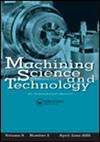Electrical discharge machining as a surface treatment process for improving the performance of microbial fuel cells
IF 2.6
4区 工程技术
Q2 ENGINEERING, MANUFACTURING
引用次数: 0
Abstract
Abstract Microbial fuel cells (MFCs), which generate low-pollution power through feeding organic trace minerals to bacteria, are crucial for applications involving energy recovery and environmental protection. In MFCs, electrodes critically influence the electrocatalytic process. In this study, an electrical-discharge-machining (EDM)-based surface treatment method for MFC electrodes was applied to a stainless-steel mesh (SSM), which was selected as an anode substrate. The experimental results indicated that EDM surface treatment formed a recast layer on the SSM anode surface. A few defects such as cracks and notches were observed after EDM surface treatment, which increased the surface and surface roughness of the SSM anode. To verify the effectiveness of the proposed EDM treatment, an Escherichia coli (HB101)-based single-chamber MFC system was fabricated, and the electrochemical activity of the EDM-treated anode was investigated through electrochemical analysis. The maximum power density of the MFCs equipped with the untreated SSM anode and the EDM-treated SSM anode under a pulse current of 1.5 A were 101.37 and 205.94 mW m−2, respectively. Thus, EDM surface treatment increased the power generated by the MFC by a factor of approximately 2. The proposed novel EDM surface treatment, therefore, has potential for development as a standard processing procedure for metal electrode substrates.电火花加工作为一种改善微生物燃料电池性能的表面处理工艺
微生物燃料电池(MFCs)是一种通过向细菌提供有机微量矿物质来产生低污染电力的电池,在能源回收和环境保护方面具有重要的应用价值。在mfc中,电极对电催化过程有重要影响。在本研究中,将基于放电加工(EDM)的MFC电极表面处理方法应用于不锈钢网(SSM),并选择其作为阳极衬底。实验结果表明,电火花表面处理在SSM阳极表面形成了重铸层。电火花表面处理后,表面出现了少量裂纹和缺口等缺陷,提高了SSM阳极的表面和表面粗糙度。为了验证电火花处理的有效性,制作了基于大肠杆菌(HB101)的单室MFC系统,并通过电化学分析研究了电火花处理阳极的电化学活性。在脉冲电流为1.5 a时,未经处理的SSM阳极和经过edm处理的SSM阳极的mfc的最大功率密度分别为101.37和205.94 mW m−2。因此,电火花表面处理使MFC产生的功率增加了大约2倍。因此,提出的新型电火花加工表面处理具有发展成为金属电极衬底标准加工程序的潜力。
本文章由计算机程序翻译,如有差异,请以英文原文为准。
求助全文
约1分钟内获得全文
求助全文
来源期刊

Machining Science and Technology
工程技术-材料科学:综合
CiteScore
5.70
自引率
3.70%
发文量
18
审稿时长
6 months
期刊介绍:
Machining Science and Technology publishes original scientific and technical papers and review articles on topics related to traditional and nontraditional machining processes performed on all materials—metals and advanced alloys, polymers, ceramics, composites, and biomaterials.
Topics covered include:
-machining performance of all materials, including lightweight materials-
coated and special cutting tools: design and machining performance evaluation-
predictive models for machining performance and optimization, including machining dynamics-
measurement and analysis of machined surfaces-
sustainable machining: dry, near-dry, or Minimum Quantity Lubrication (MQL) and cryogenic machining processes
precision and micro/nano machining-
design and implementation of in-process sensors for monitoring and control of machining performance-
surface integrity in machining processes, including detection and characterization of machining damage-
new and advanced abrasive machining processes: design and performance analysis-
cutting fluids and special coolants/lubricants-
nontraditional and hybrid machining processes, including EDM, ECM, laser and plasma-assisted machining, waterjet and abrasive waterjet machining
 求助内容:
求助内容: 应助结果提醒方式:
应助结果提醒方式:


